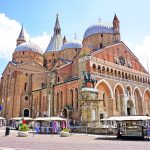San Giovanni Rotondo, a modest town in the region of Foggia, southern Italy, has become one of the most important pilgrimage sites in Europe because of a man who lived and died here less than a century ago: Padre Pio of Pietrelcina. Unlike ancient shrines tied to centuries-old relics or medieval miracles, this place carries the living memory of a friar whose reputation for holiness and suffering drew people even in his own lifetime. A pilgrimage here is not about walking the ancient routes of history alone—it is about touching a modern chapter in the long tradition of faith.
In this article, we’ll explore what pilgrims experience when they come to San Giovanni Rotondo, why Padre Pio continues to inspire millions, and how to plan a journey here with both reverence and practical sense.
Who Was Padre Pio?
Francesco Forgione, known to the world as Padre Pio, was born in 1887 in Pietrelcina, a small village in Campania. At the age of 15 he entered the Capuchin friars and took the name Pio. From early in his priesthood, he experienced extraordinary spiritual phenomena: visions, battles with what he described as demonic forces, and later, the stigmata—the wounds of Christ on his hands, feet, and side.
These marks, which he carried from 1918 until his death in 1968, drew controversy and deep devotion. The Church at times limited his public ministry while investigating these signs, yet for ordinary people his reputation as a confessor and intercessor grew steadily. Thousands came to San Giovanni Rotondo seeking his counsel and his blessing. Today, millions continue to come, convinced that Padre Pio’s life was one of deep suffering united with compassion and prayer.
The Sanctuary of Saint Pio
The heart of the pilgrimage is the Sanctuary of Saint Pio, a massive complex built to accommodate the millions of visitors who arrive each year. Its most striking feature is the modern church designed by the architect Renzo Piano, completed in 2004. Unlike the Gothic or Baroque basilicas familiar across Europe, this sanctuary is shaped in sweeping arcs of stone, built to hold 7,000 worshippers inside and many more outside.
Beneath it lies the crypt where Padre Pio’s body rests, displayed in a glass coffin. Pilgrims move slowly past, many kneeling or praying silently, some leaving flowers, photos, or small notes of petitions. This moment often defines the pilgrimage: an encounter with the physical remains of a man many believe still intercedes for the suffering and the sick.
The older church, Santa Maria delle Grazie, remains a vital stop as well. This is where Padre Pio spent much of his life, celebrating Mass and hearing confessions for hours each day. The friary attached to it includes his simple cell, preserved much as it was at his death—books, crucifix, and worn furniture testifying to a life of austerity and prayer.
What Pilgrims Experience
Pilgrims to San Giovanni Rotondo often speak of two things: a sense of Padre Pio’s nearness, and the encounter with suffering. This is not a shrine that hides the reality of pain. Padre Pio himself bore visible wounds and offered his life in solidarity with those in agony. Many who come here are sick themselves, or bring the names and hopes of loved ones.
The hospital founded by Padre Pio, the Casa Sollievo della Sofferenza (“House for the Relief of Suffering”), remains one of the most advanced medical centers in Italy. Pilgrims often visit not only the sanctuary but also this hospital, seeing in its work a continuation of Padre Pio’s care for the sick.
Liturgies, confessions, and moments of silent prayer mark the rhythm of the pilgrimage. Some visitors find peace in quiet corners of the sanctuary; others are moved by large Masses where the devotion of thousands seems to lift their own prayers higher. For many, the experience is deeply personal—an answered prayer, a renewed faith, or simply the recognition that suffering can be met with love and dignity.
Planning a Pilgrimage
When to Go:
San Giovanni Rotondo is busiest on Padre Pio’s feast day, September 23. While this can be a moving time, with processions and large gatherings, it also means crowds. Pilgrims seeking a quieter experience may prefer spring or autumn outside the feast day, when the weather is mild and the town less full.
How to Get There:
The nearest airport is in Bari, about 150 kilometers away. From Bari, buses and trains connect to Foggia, and from Foggia a bus or car ride takes you up into the mountains where San Giovanni Rotondo lies. The town itself is walkable, though hilly, with most accommodations close to the sanctuary.
Where to Stay:
Hotels and guesthouses abound, ranging from simple pilgrim accommodations run by religious orders to modern hotels serving large groups. Many pilgrims choose to stay near the sanctuary for convenience, especially if they want to attend early morning Masses or late evening devotions.
What to Do:
- Visit the Sanctuary of Saint Pio and spend time in prayer at his tomb.
- Walk through the older Santa Maria delle Grazie Church and Padre Pio’s friary cell.
- Attend a Mass or confession, sharing in the same sacraments that defined his ministry.
- Tour the Casa Sollievo della Sofferenza, if possible, to witness the medical mission Padre Pio envisioned.
- Explore the surrounding Gargano mountains, a rugged landscape that invites reflection.
A Pilgrimage of the Heart
A journey to San Giovanni Rotondo is not about ancient relics hidden in gilded chapels or medieval legends retold for centuries. It is about a man who lived close enough to our time that film and photographs preserve his presence. Pilgrims walk streets he walked, pray in the same chapel he prayed, and see the bed where he died.
But the deeper pilgrimage is not one of geography. It is the inward journey into the mystery of suffering and holiness. Padre Pio is remembered not for building monuments or writing volumes of theology, but for listening, for suffering alongside others, and for pointing them to God. To visit San Giovanni Rotondo is to enter into that same mystery: to bring one’s wounds, physical or spiritual, and lay them in the presence of a man who bore his wounds with faith.
Final Thoughts
For those planning a pilgrimage, San Giovanni Rotondo is both a physical journey into the Apennine mountains of southern Italy and a spiritual step into the reality of human fragility and divine grace. It reminds us that holiness is not distant but close, lived out in the lives of ordinary men and women who choose faith amidst hardship.
Padre Pio’s story continues to resonate because it is not polished or easy. It is marked by pain, controversy, and endurance. And perhaps that is why so many continue to come: not to find perfection, but to find hope.






